Welcome to today’s edition of ShentonSTAGE.
I am moving my diary of the week and digest of the week’s openings to today, instead of Monday, which from now on will concentrate on the week ahead.
DIARY OF THE WEEK
MONDAY APRIL 18
- My newsletter today is a digest of the previous week, over half of which I spent in hospital having a revision surgery to the spinal fusion I originally had in September 2020, plus my reviews round-up of the week, and openings this week. https://shentonstage.com/shentonstage-daily-for-monday-april-18/
- Twitter thread of the day is from an audience member who attended a preview FOR COLORED GIRLS (that opened this Wednesday at the Booth Theatre, see reviews below), about a pair of latecomers, who enter late talking loudly, and proceed to chomp loudly through a box of candy, with the husband taking calls on his mobile phone (and claiming in mitigation when challenged that he’s a doctor), except for one occasion when instead of switching to off, he simply allows to let it ring out. It’s simply unbelievable that this behaviour is still happening; surely we’ve reached a point where it should no longer be tolerated.
TUESDAY APRIL 19
I’ve bitten the bullet and decided to return to the Edinburgh Festival and Fringe this year again, for the first time since God knows when. I’ll only be dipping my toe in, mind you — I’m not doing anything so rash as contemplating a full week, let alone the full monty — but will go up for a three night stay from August 21-24.
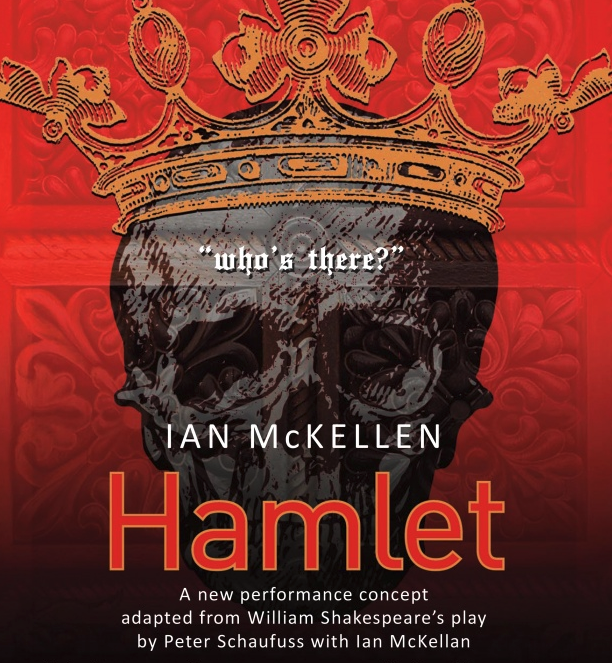
That’s to coincide with a friend who is doing a fringe play from August 22-28 at Surgeon’s Hall; catching Ivo van Hove’s International Festival show A Little Life at the Festival Theatre (running August 20-22); and of course, Ian McKellen’s latest (heavily abbreviated) Hamlet at Ashton Hall at St Stephen’s (August 2-28).
By that stage of the fringe, too, other shows should have emerged that will be must-see, as well as the ones to be avoided.
WEDNESDAY APRIL 20
Tonight I go to see THE TAXIDERMIST’S DAUGHTER, the opening play of the 60th Chichester Festival Theatre summer season, which is proudly both by a local writer, novelist Kate Mosse adapting her own book for the stage, and a local story. I am now, myself, a local — I live 20 minutes drive from the theatre in a little village on the South Downs called Amberley; a follower on Twitter tweets when I say I’m seeing it, “Are you enough of a local now, to get the local in-jokes? Enjoy!
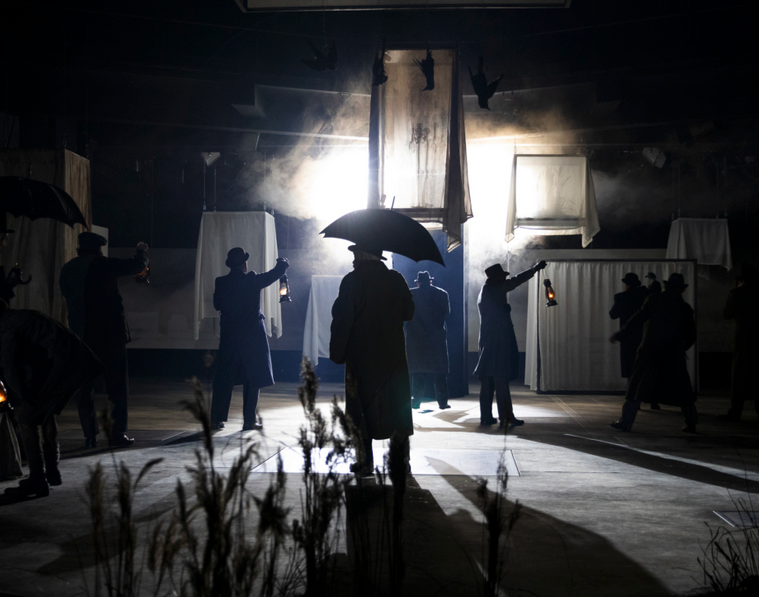
Actually, I’ve not been here long enough to have visited the villages of Fishbourne and Apuldram, where the action is set in 1912; but there’s something to be said for a local theatre — albeit one with a huge national reach, whose shows regularly transfer to the West End — to be speaking directly to its own immediate community. And this play, with an adult cast of over 20 people, is an impressive achievement for a new play, which these days tend to be more skewed to the sort of two handers like David Eldridge’s MIDDLE, which begins previews at the National’s Dorfman next week; certainly if a play is to get a future production, it will need to have a smaller cast these days.
So watching THE TAXIDERMIST’S DAUGHTER, I got the sense that not only was I watching this local story on its home ground, but that I was more than likely seeing it on its ONLY ground. And given that the play is only programmed for a run of three weeks and two days, it’s a notable commitment from both the theatre and the cast to have spent so much time and resources bringing it to the stage.
Director Róisín McBrinn marshals the sprawling action with atmospheric intent, and Paul Wills set has video by Andrzej Goulding that allows for an enveloping storm to flood the stage of the theatre; it provides a gripping slice of local drama that puts Chichester itself at the centre of its own landmark anniversary season.
- My newsletter today was on the differences between excitable gush and real theatre criticism; and how different restaurant critics can respond to the same establishment, as shown by Giles Coren and Jay Rayner’s completely opposite reviews of the revamped Richoux in Piccadilly last week demonstrated. To read the full column, visit https://shentonstage.com/shentonstage-for-wednesday-april-20/
THURSDAY APRIL 21
- In a diary column for The Times yesterday, chief theatre critic Clive Davis says that one of the downsides of the job is having “to wade through programme notes which are the equivalent of an A-level syllabus.” Mind you, at least he’s not had to pay for the privilege, as critics are routinely given a free programme with their tickets. Myself, i’d be happy enough with a simple cast list and to let the show speak for itself. (Another downside is what to do with them afterwards. Since I get so many, I long ago decided I could no longer hang onto them: but I don’t like to simply recycle them with my other paper recycling, as I feel they may be of value to someone. In the past I’d bundle them up every few months and take them to ArtsEd when I taught there; I must arrange to do the same thing with a drama school more locally to me now in West Sussex).
If only we had something similar to the Playbills that are given out free on Broadway as you take your seat; not only does it give those that want it a free souvenir of their visit, but it ensures that everyone has access to all the cast and creative credits, and something that may be an aide-memoire to where you’ve seen their work before.
But it’s also a useful marketing tool for Broadway itself, as the outer-binding of the magazine has short interviews and feature articles that change every month about different shows now playing on Broadway.
FRIDAY APRIL 22
While I’m still in recovery mode from my spinal surgery last week, I’ve had to forego the pleasures of my usual trips up to London; but thanks to live-streaming, London has come to me, or at least a night at Crazy Coqs, my favourite cabaret destination, has, where this week Broadway’s Lillias White has been in residency with pianist Billy Stritch.
I’ve seen her live in her native New York many times since I first noticed her in the 1995 Matthew Broderick revival of HOW TO SUCCEED IN BUSINESS WITHOUT REALLY TRYING, her Tony award winning role in THE LIFE In 1997 and the original Broadway cast of FELA! in 2009, as well as a cabaret run at a new long-gone room Arci’s Place, on Park Avenue South in 2000.
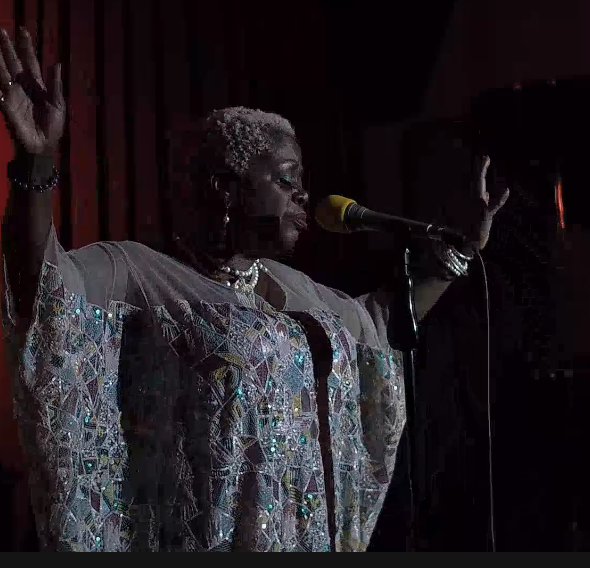
I wish I’d been able to get to London to see her live, but watching the live stream was the next best thing; she is both fierce and fabulous. She has a huge voice and even bigger presence. She is one of those divas that Broadway seems to specialise in. She was Effie White in the 1987 Broadway return of DREAMGIRLS, though she actually wanted to be Lorrell; last night she performed “I Am Changing” and it was thrilling.
- Announcements of the week

- Casting has been announced for Bath Theatre Royal’s production of INTO THE WOODS, running from August 17 to September 10, with press night on August 25. The cast features Nicola Hughes as the Witch, Rhashan Stone as the Baker, Alex Young as the Baker’s Wife, Audrey Brisson as Cinderella and Julian Bleach as Mysterious Man. Young is currently to be found in the Sondheim curiosity ANYONE CAN WHISTLE at Southwark Playhouse, which I’m going to finally catch next Tuesday afternoon.

- Casting for the King’s Head’s new production of LA BOHEME, running April 26-May 28, press night May 3), which relocates the story to contemporary London in David Eaton and Adam Spreadbury-Maher’s libretto, reworked by Eaton (who is also musical director) and Philip Lee (who also plays Mimi).The rest of the cast comprises Matthew Kellett as Marcus, Grace Nyandoro as Marissa and Daniel Koek as Robin.

- On Wednesday, the Royal Court announced a main house debut for a previously unproduced playwright Dave Davidson, who has worked in the security industry for the last 38 years and has now written his 1st play, THAT IS NOT WHO I AM, to be premiered in the Theatre Downstairs from June 10-July 16, press night June 16. The press release provided endorsements of his work by Simon Stephens and Dennis Kelly; but also has this cryptic statement:
“Please note Davidson is highly security conscious and therefore there will be no images supplied of him or any available throughout the run of the production. Any images or biographies for ‘Dave Davidson’ online are attributed to other individuals with the same name, not this playwright. Dave is open to interviews but no photos.”
Time Out theatre editor Andrzej Lukowski reveals he was offered the exclusive announcement of the play, before the rest of us got it; he rewards it by quoting the Stephens and Kelly statements, and then reporting,
“We don’t know any more, and in true Royal Court-style there’s no casting announced yet (because they don’t want actors to upstage writers), and basically no creative team either, though we do know that theatre associate Lucy Morrison is lined up to direct. All that we can say is a very paranoid guy called Dave Davidson is about to have his first play staged at the Royal Court, and we sincerely hope its faith in him is rewarded.”
We sincerely hope that the Royal Court’s faith in TIME OUT to disseminate its exclusives is similarly felt to have been rewarded.
For more details and press contacts for these productions, visit my updated list of forthcoming productions in London, selected regional theatres and on Broadway here: https://shentonstage.com/theatre-openings-from-w-c-april-18-onwards/
Openings of last week: London and beyond
In my Wednesday newsletter, I noted some of the gushing early on-line responses to BONNIE AND CLYDE, which opened the night before at the Arts; the “print” reviews, as the old newspaper ones might once have been called, have been a whole lot more measured, even dismissive. In a 2-star review for The Guardian, Ryan Gilbey opens with a spoiler, but one that is entirely permissible: “A note for anyone unfamiliar with the Depression-era bank robbers Bonnie Parker and Clyde Barrow: they died in the end. In the musical Bonnie & Clyde, they die in the beginning, too.”
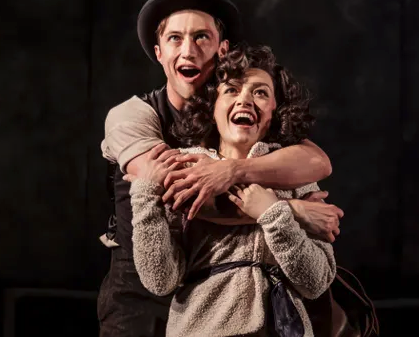
In a 3-star review for The Stage, Tim Bano calls the show “DOA” and “puddle deep”, but he has much to praise amongst the company. “Luckily for the writers, the cast couldn’t mesmerise more. Out in front are Natalie McQueen as Clyde’s sister-in-law Blanche and Jordan Luke Gage as Clyde [above left]. McQueen nails the tone of the show: comic, superficial, having an absolute blast, her voice starting with Dolly Parton and ending with Kristin Chenoweth… Frances Mayli McCann [above right] has particularly little to latch on to in Bonnie, but her voice is a godsend. At the forefront of the action, Gage has an absolute blast as Clyde. For most of the show he’s got a big grin, as if he’s enjoying the ride, while his voice seems to know no bounds. But what clinches his performance is the moment his childish playfulness slips into malevolence.Thank goodness for that ensemble. Outshining their material, we’re left with a feeling that, like Bonnie and Clyde themselves, the show could have been so much more, and should have done so much less.”
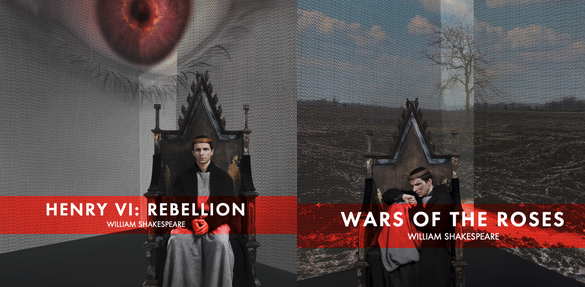
Wednesday saw a press day at Stratford-upon-Avon for the RSC’s HENRY VI. But when one person attending it tweeted a line directly from the play, he was temporarily suspended from Twitter:
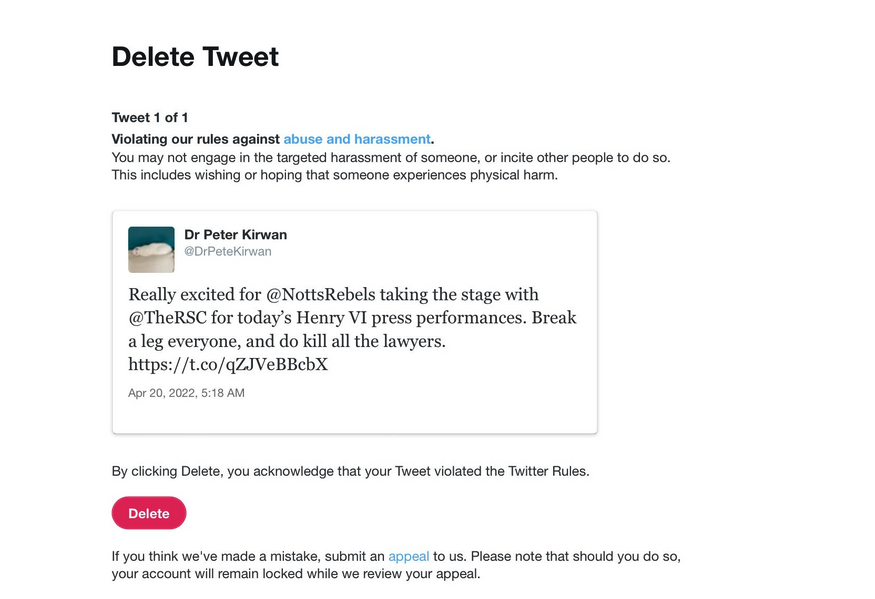
In a joint review of both parts for The Stage, Dave Fargnoli writes that director Owen Horsley “gives both plays a dynamic staging, with a consistent, hyperbolic style tying together the disparate parts. Henry VI: Rebellion is the weaker of the two (★★), an ominous, slow burn of a show with most of the action pivoting on the political manoeuvring within a court corrupted by factionalism and individual ambition.… Wars of the Roses (★★★★), by contrast, is a significantly more focused and intense experience, packed with brutal killings and devastating reversals of fortune. Horsley gradually, methodically ratchets up the tension as armies clash and characters are captured, exiled, or cut down. But importantly, he also creates some breathing space for relatable emotional beats to develop, enriching the story by allowing humour, grief, and small, humanising moments of tenderness to break through the relentless violence.”
 ,
,
Mark Quartley (pictured above as Henry VI, above) “plays King Henry VI as kindly, awkward and, at times, almost childlike, trying his best to live up to a kingly image of solemn dignity but nevertheless given to little outbursts of exuberance or sudden fainting episodes. At one point, gutted by grief over the murder of his beloved uncle, he writhes around on the floor, clinging onto his cursed crown like a teddy bear.”
In a joint review for The Times, Clive Davis calls Quartley’s Henry “an indecisive yet curiously sympathetic monarch. This is no caricature of a milksop: he may be prone to moments of self-pity, but Quartley gives us a monkish introvert who, by the time he meets his violent end, has a touch of saintliness about him. At the other end of the moral spectrum is Arthur Hughes’s resentful young Gloucester, slowly growing into the malevolent force that will become Richard III. (Hughes — born with radial dysplasia, a condition that affects his right wrist and arm — will play the king at Stratford this summer, becoming the first disabled actor to be cast in the role at the RSC.)”
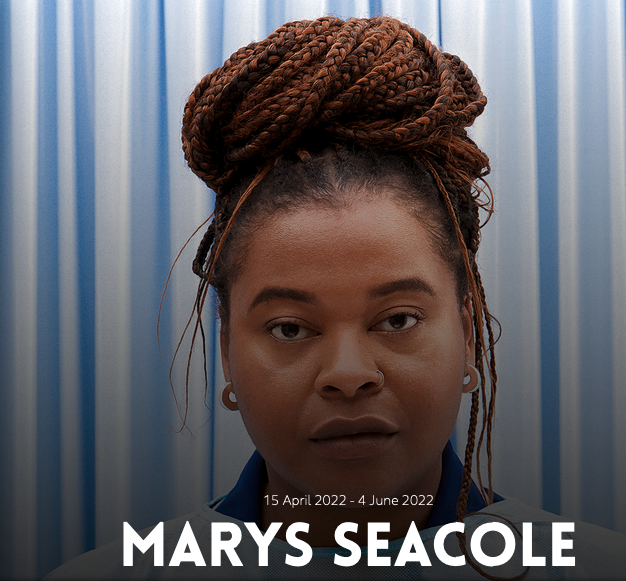
Last night (Thursday April 21), the Donmar Warehouse offered the UK premiere for Jackie Sibblies Drury’s MARY SEACOLE, directed by Nadia Latif, who previously also directed Drury’s FAIRVIEW at the Young Vic. Reviews are yet to appear so I will update on Monday with those.
Yesterday also saw the official opening of Punchdrunk’s return to London with their first show THE BURNT CITY here since 2014, in their new home occupying two giant warehouses at Woolwich Arsenal. The only review I’ve seen so far is Sarah Crompton’s for WhatsOnStage, which also reassures me that I’ve made the right call not to bother to see it: “Most of the time, though, I hadn’t a clue what was happening. Maybe that’s my fault: this is a piece that seems to require a better understanding of the intricacies of ancient myth and Greek and Roman literature than I actually have. But because I was confused, the emotional impact of all this immense labour was less powerful than it should have been.”
A busy week on Broadway (and it’s not over yet)
Broadway saw a succession of openings this week. My Wednesday newsletter already covered the reviews of the revival of Paula Vogel’s HOW I LEARNED TO DRIVE that opened the night before at Manhattan Theatre Club’s Friedman Theatre, which reunited the leads Mary-Louise Parker and David Morse from its original Off-Broadway bow in 1997.
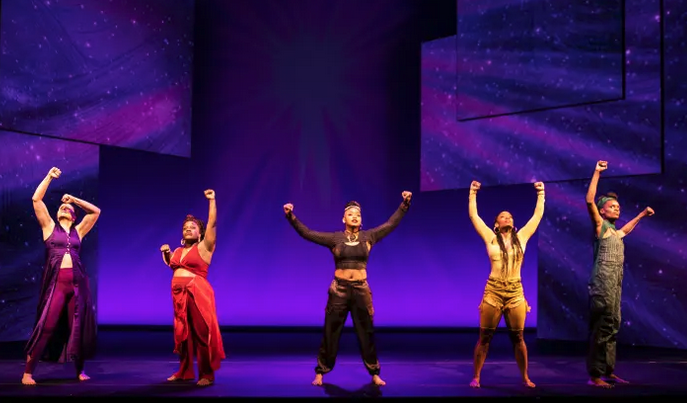
Wednesday night saw the return of Ntozake Shange’s “choreo-poem” for colored girls who have considered suicide/ when the rainbow is enuf to the same Booth Theatre where its original production transferred from the Public in 1976, in a new production directed and choreographed by Camille A Brown, shattering a glass ceiling as she became the first Black woman to serve as both director and choreographer on a Broadway production in more than 65 years. It’s on occasions like this that it’s probably more respectful to defer one’s critical responses to those whom the play is directly addressing, like Variety’s Ayanna Prescod, a female person of colour, who says,
“Throughout the production, themes of visibility filter through every enunciated breath and rhythmic melody. With the ladies’ natural crowns beautified with box braids, locs and shaped afros, the impressive ensemble of seven performers seamlessly works in tandem to create a kaleidoscope of dazzling Black femininity, making it impossible to look away. Every woman here has a story, a complication or an awakening deserving of an ear. Or several…. Shange’s work remains as riveting as it was in 1976. Her words have become more than the unspoken and unrealized accounts of Black women’s pain and promise; they have evolved into the gift of permission to heal and the agency to be seen and understood. It has become a memo to Black women to embrace their femaleness (no matter what that looks like) while looking to the rainbow as a sign of hope for the future of the collective, because they alone are enough.”
By contrast, Johnny Oleksinski in the New York Post finds the play isn’t enough, writing that it “comes across, unfortunately, as an antiquated time machine that’s at odds with the current conversation. Being a glimpse into a specific, different era would be OK — plenty of revivals fit that bill — but for colored girls seems awfully intent on speaking forcefully to the present moment. A strong connection to today, however, is nowhere to be found.Although women’s suffering — the main topic — has sadly never gone away, the manner in which it’s discussed in Ntozake Shange’s work is uncomfortably antiquated. For one, the poetry piece, which has been widely acclaimed through the years, is built around an old-school feminism that’s dependent on women loudly railing against men.”
It may not be intended for a white male critic, in that case. Nor, even necessarily, a white female critic, either: as Laura Collins-Hughes writes for the New York Times, these women “do not have great luck with men, and Shange caught plenty of flak from Black men who did not like the way she portrayed them. She objected to their objection, and noted: For Colored Girls was and is for colored girls.” (That means Shange didn’t write it for me, either, I realize.)”
And it is why Broadway needs a wider range of critics, too, which it is now fortunately at last getting. This is exemplified by Brittani Samuel, who relates intimately to the show in a review for Broadway News:
“It starts with a step. Stomp. Clap. A crescendo of joyous movement and affirmations (“ayeee, yessss, you better”) erupts on stage and is immediately echoed by members of the audience, most notably, the Black female ones like me who came to experience this very specific brand of healing. Seven actors cloaked in the colors of the rainbow mime a game of double dutch, whipping me right back to childhood, playing in my grandmother’s concrete Brooklyn yard. How does she always do this, I wonder? How does Ntozake Shange always bring me back home?”
She also carefully places the production in an admirably careful and concise theatrical context, stating that it “is one link in a chain of productions re-introducing the work of our titans — Alice Childress, Adrienne Kennedy and more — to modern audiences. Only Shange’s work has been on Broadway before, first premiering at the Booth Theatre, where the revival is currently playing, in 1976. It remains a seminal, sacred text; one I’ve been able to recite phrases from for the better half of my life. This revival, by director and choreographer Camille A. Brown, is the most essential production of Shange’s masterwork to date.”

On Thursday, Martin McDonagh’s Hangmen finally opened at Broadway’s Golden Theatre, four years on from the Off-Broadway run of this production at the Atlantic Theater Company and two years after its original transfer (also to the Golden) was aborted during previews when the pandemic shut down Broadway; the producers announced that it would not be returning. But now — substantially re-cast since then — it has come back, with a cast newly led by David Threlfall and Alfie Allen, while Andy Nyman (who also did the play at the Royal Court and in the West End) and Tracie Bennett are amongst those who have returned.
In his review for the New York Times, Jesse Green writes of how the four years between first seeing it at the Atlantic and now on Broadway have changed the play: “Four years later, the world feels coarser — perhaps it always does — and not just because death has become much more visible in streets and wards and wars. So has people’s indifference to it, and to all kinds of suffering and unfairness. McDonagh’s cynicism feels closer to our own, or rather we to it. HANGMEN now plays less like a clever exercise and more like news, with an unnerving headline. Garden-variety amorality is not a far throw from violent psychopathology, it reports, or for that matter from what we call justice.”
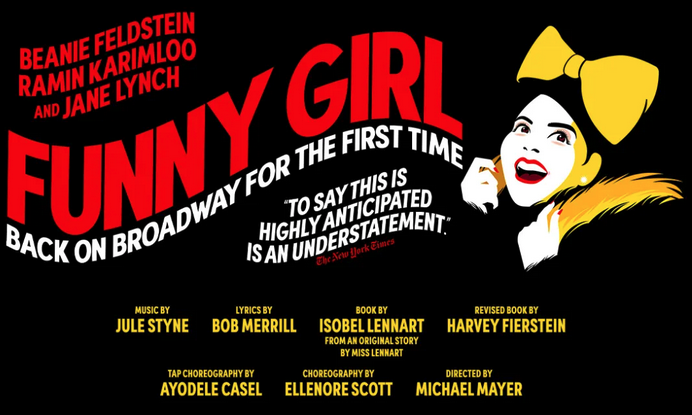
There’s still one more opening to come this weekend: FUNNY GIRL will open at the August Wilson Theatre on Sunday April 24, in its first Broadway revival since the show made a star of Barbra Streisand in 1964. See Monday’s newsletter for a review round-up.
SEE YOU ON MONDAY
If you can’t wait that long, I may also be found on Twitter here: https://twitter.com/ShentonStage/ (though not as regularly on weekends).
